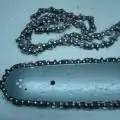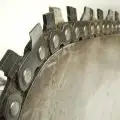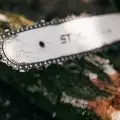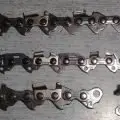It’s likely that you use your chainsaw frequently if you’re reading this article. Your chainsaw bar, however, is made to do more than just cut things; it’s also intended to help you keep your chainsaw safe and extend its life.
Regular maintenance is necessary to keep your chainsaw bar in good condition. When you take care of your bar, you safeguard both your hands and your tools. Instead of having to make the trip to the service center, you can perform these tasks at home.
In this article, we will provide all the relevant chainsaw bar upkeeps and maintenance tips, along with why and how to dress a chainsaw bar to extend its life.
Table of Contents
- Chainsaw Bar Upkeep and Maintenance
- Dressing a Chainsaw Bar – How & Why
- FAQs (Frequently Asked Questions)

Chainsaw Bar Upkeep and Maintenance
One of the most important components of a chainsaw is the bar. Your chainsaw may begin to deteriorate and produce issues if you don’t keep it in excellent condition. So, if you want to preserve your chainsaw bar in top shape, here are some crucial tips to follow.
Maintain Correct Chain Tension
One of the most crucial factors in keeping your saw operating well is the chain tension. A more consistent and strong cut will be produced by a chainsaw with a properly tensioned chain and the suitable chainsaw chain direction. A chain that isn’t correctly tensioned can overheat, perform poorly, and even break teeth.
Checking the tension on your chainsaw bar using a torque wrench is a great method to find out if it is too much or too little. Simply insert the tool between the bar and chain and tighten it until it locks in place. If there is too much strain, let it go until the movement between the two parts is no longer greater than 1/4 inch.
More about parts of a chainsaw on the blog.
Keep Your Chainsaw Lubricated
To keep your chainsaw bar running at its best, you should frequently oil it in addition to keeping the chain properly tensioned over the blade. By doing this, the bar is kept clean and free of debris that could obstruct its ability to cut efficiently. Visit our chainsaw oil types and chainsaw bar and chain oil substitute guides for more information!
It’s crucial to keep in mind that lubricating only functions when suitable synthetic oils like WD-40 or TriFlow are used (available at most hardware stores). You must remove any leftover oil before adding new oil if you use ordinary motor oil rather than synthetic oils.
Rotate Chainsaw to Alternate Sides at Regular Intervals
You should rotate your chainsaw bar from side to side at regular intervals to keep it balanced and prevent accumulation on one side. By using this technique, you can ensure that your chainsaw is free of rusted spots or other problems that could impair its operation. To make this operation easier for you, rotate the bar by hand or with a tool like a screwdriver or extension wrench. If necessary, you can also use an electric drill.
Use Correct Chainsaw Lengths For Specific Jobs
The length of a chainsaw bar is determined by measuring it from the cutting edge’s tip to heel. The chain saw bar will be simpler to handle and maneuver around trees the shorter it is. To avoid harm to your tools, you should use a longer chain saw bar while working with large trees. There are many uses for various chainsaw bar types, but there are also some general rules that are applicable to all chainsaw bar types:
Any chain saw with a bar between three and four feet long can be used if you’re using a small tree trimmer or pruner. With these solutions, you can get close enough without having to be concerned about destroying your tools. Alternatively, think about utilizing a chain saw bar that is 4 feet long if you need more strength to chop through larger trees. Visit our chainsaw chain sizes guide for more information!
Switch Your Chainsaw Bar if Necessary
Make sure you first purchase the correct length if you need to replace your chainsaw bar with one that is a different length than the old one (which may occur if your chain breaks). By doing this, you can prevent experiencing saw-related issues and replacing more parts than necessary.
Following are some pointers for changing your chainsaw bar:
When securing the replacement bar with your wrench/socket set, avoid using any oil on the shaft. When you begin tightening the bolts on either side of the shaft in tandem, this will stop slippage.
Before using your new chain for any project, make sure it is properly positioned on the teeth of your saw’s sprocket. This will ensure that there isn’t any excess play in the chain after it has been fitted.
If at all feasible, test the amount of force needed by pulling on one side of the bar while simultaneously holding onto the other side with both hands. This way, you can determine exactly how much force is necessary to get the job done without everything falling apart.
Dressing a Chainsaw Bar – How & Why
Why Dress a Chainsaw Bar
The main cutting component of a chainsaw, the chain, is guided precisely by chainsaw bars. The guide bars are subject to operational wear and strain, much like the chain, affecting the chainsaw’s ability to cut. Usually, wear can be seen as burs and uneven rail edges. To fix these, a chainsaw bar needs to be dressed using a hand dressing tools or belt sander.
How to Dress a Chainsaw Bar
To remove burs on the rail edges, chainsaw bar can be dressed with a flat file or belt sander. There is also a unique rail dressing tool that files the bar’s rails at a 90-degree angle.
Using a Hand Dressing Tool:
For this method, a rail dresser is available. You can buy this tool online or via specialized retailers. It can be used on a number of bars and is reasonably inexpensive. I’ll walk you through each stage of using this tool:
1. Clamp the Bar
The bar needs to be tightly secured in a fixture before being dressed. The bar could be fixed using a bench vise. Please make sure the bar is positioned such that its rails are facing up and its shortest edge is wedged between the wise jaws.
Get Your Dressing Tool
The purpose of filing the rails is to remove the burrs from them. If you have a flat-file instead of the dressing tool mentioned above, you can still accomplish this. The benefit of using this instrument is that it requires less effort to cut at a 90-degree angle. It’s also affordable and effective with most bars (Stihl and Oregon).
File the Rails
Apply pressure to the rails’ upper surface using the dressing tool’s file. Progressively press down on the rails. When you start to feel metallic chips being scraped off the rails, move the tool ahead. Repeat the filing process numerous times until the top edge of the rails looks smooth rather than sharp. Complete this action on the opposite side of the bar too.
Visit our Chainsaw File Sizes Chart to learn more about the various chainsaw file sizes!
Tip: To quickly identify the pits and bumps once the rails have been smoothed with the file, it is preferable to mark the rails with a blue marker before treating.
Using a Belt Sander:
Operating belt sanders is not too difficult. Using the dressing tool and the sander together is probably the finest technique to dress a bar. The dresser tool does a decent job of cleaning off metal chips, but it doesn’t square the sides of the rail, which could cause the chain to rest unevenly.
To use the sander, align the rails of the bar with the belt and firmly press inward until the rail edges are nicely finished and smooth. On the opposite side of the bar, repeat the same process.
The best tool would be a hand grinder with an 80GR flat disc if you wanted to remove a lot of material. If your bar has acquired small bumps along the rails, doing this may be desirable. A dresser tool wouldn’t be useful in this situation to remove that much material.
FAQs (Frequently Asked Questions)
How long does a chainsaw bar last?
The chain can survive for more than five years if you use the chainsaw every day. However, if you only use it sometimes and keep it in good condition, it can survive for decades. It’s because the chainsaw’s “teeth,” or blades, are worn down with each use and eventually become dull.
What causes a chainsaw bar to wear out?
The bar will experience uneven wear and damage from improper tension more often than not. Put on a pair of gloves and slide the chain along the top of the bar to check the tension after the chain has cooled and the saw has been switched off. The chain should slide freely but feel snug.
How do you tell if a chainsaw bar is worn out?
Common signs that a chainsaw bar is worn out and needs replacing are: a damaged or bent bar, the chain wiggles side to side on the bar, the edges of blades are tilted at an angle, and a jammed or damaged bar nose sprocket. If you’re experiencing any of this scenarios, ensure you repair the chainsaw bar before proceeding to use it.
Do chainsaw bars need grease?
Every time you refill, it is advised that you lubricate the bearing in the bar’s tip. To help stop moisture from entering the bearing when the bar cools, be sure to lubricate the tip at the end of the day as well.





